The Lost World of Polissya
Land of Forests and Marshes
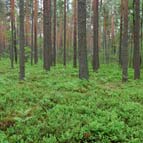
The scenery began to quickly change and ac quire quite wild and pristine appearance soon after our bus rolled past the town of Ovruch which is a regional center. The road leaves the flat Ovrutsky Kryazh plateau going downhill and plunges into a forest. At one point, l discovered there was no mobile telephone service available there which came as another proof of our enfettering utter wilderness. And the was no longer asphalt but paved with local quartz stones of an amazing pink color. This quartz can be used for decorative purposes in construction and there it was used for paving the road.
There was no traffic on the road that took us all the way to its end at the village of Selezivka of only seventy households. This village which is situated 70 kilometers from Ovruch, happens to be the center of the Polissya Natural Preserve.
The preserve which is located between the Rivers Ubort’ and Bolotnisya, is only a part of an immense stretch of forests that goes all the way into the neighboring state of Belarus. The area is a marshland and marshes have kept that area from being widely cultivated. Hence its pristinely wild condition. The people have been living in that area of sand dunes, marshes and impenetrable forests (known from the times of old as Drevlyan’) in isolation from more civilized lands for centuries. At present, they are usually referred to as Polishchuks. They have developed their own distinct culture, customs and habits. They could not grow a lot of grain and hat to live off the forests and marshes. As late as in the first half of the twentieth century most of the Polishchuks lived in what was called “khutory” (individual farmsteads, country retreats) rather than in villages. The locals continue to keep traditional beehives which placed in the woods. They use very little or no agricultural machinery still relying on horses and scythes and sickles. Though they are Christians their Christianity is greatly influenced by the primordial pagan beliefs an customs. The locals resent administrative pressure, they are wary of strangers, and l was told one should be careful not to offend them by a flippant remark. Many of the locals believe in werewolves, in the magic powers of witches and wizards, and in magic rather than in digital wonders of today.
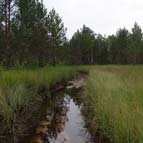
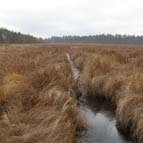
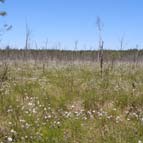
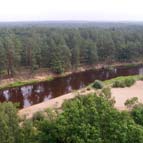
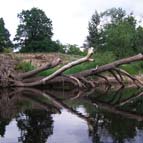
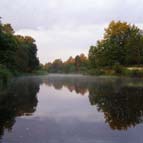
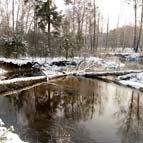
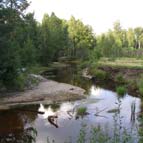
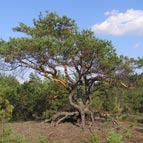
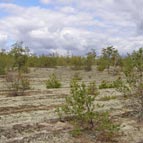
Werevolves
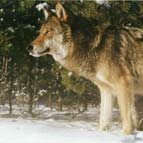
The director of the Polissya Preserve Serhiy Zhyla found a plaze for us to stay in the village for two days and offered to be our guide. He is a person of long local experience who loves wild life and the land he lives on. He took us along ecological paths in the forest, he patiently answered many of our sometimes nave or silly questions, he told us many local stories and stories about wild life – and he said almost nothing about himself. He showed us a great many photos he had taken – all kinds of unusually or odd looking plants, huge trees, birds, insects and other animals. He said that some of the photos were “just lucky moments” but to take many others he had had to spend hours in waiting for the right moment to snap a picture. Some of the photos showed a bad forest fire and efforts taken to put it gown. Among the photos were those of a baby lynx saved from the fire. After it had been nursed back to health, the lynx was released into the forest.
Quite a few photos showed wolves – “there are quite a few of them here,” Serhiy Zhyla said. From his stories it was clear that he knew wolves and their behavior well. He even had domesticated a couple of wolf puppies. He believes that stories about werewolves are not idle fantasies – “local magicians can turn themselves into wolves – not in the sense of they physically becoming four-legged, overgrown with fur and armed with fangs, but in the sense of their mentality and psychology”.
Serhiy Zhyla published a book, Vovche-brate, vybach mene hrishnoho (Brother Wolf, Pardon Me Sinner That l Arm), in which he described relations of man and habits. Signing a copy of his book for me, he wrote, “From a werewolf of Polissya Preserve.”
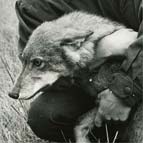
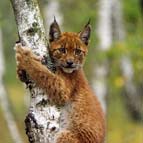
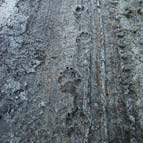
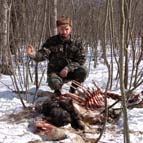
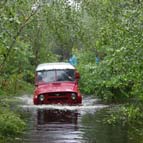
Mills and memorial stones
At the edge the village an old-style wind mill has been recently built. An old mill in the village of Dalety where no one lives now, was taken apart and the parts were brought to the Polissya Preserve where they were reassembled, and the missing parts made and fixed in proper places. The locals did not need any blueprints to e erect the wind mill – they still remembered well how a mill should be built and how operated. In fact, this mill was to be more than just an ethnographic decoration – it is in a working condition and will be used for grinding grain grown by the villagers. Millstones were carved from local rocks quarried at the plateau.
At the edge of the forest where we were taken by Serhiy Zhyla, we saw a sort of a monument, the inspiration on which said, “It is erected in honor and in memory of the old wise men, magi, Cossacks, witches and all those who died for the old beliefs. May they rest in glory and life in our grieving memory.”
Serhiy Zhyla is of the opinion that historians have never been fair in their attitudes to the people of Drevlyan’ who got a bad reputation thanks to some of the ancient chronicles. “Even the very name of that land is avoided to be mentioned, the area being described as Eastern Volyn’, or Northern Zhytomyrshchyna or a generalized word, ‘Polissya’, is used.” He claims that the people of Drevlyan’ (Drevlyane were people of the forests, and Drehowychy were people of the marshes) had their own distinct culture and their own traditions some of which have been preserved to the present day. According to Serhiy Zhyla, some people, even though they may attend church regularly, venerate certain rocks, groves and water wells at places that used to be pagan shrines.
We were shown such a restored pagan shrine with twelve differently shaped megaliths installed there. “People do not come to worship here any longer,” he said, “but l wanted to preserve this place as a landmark.” He complained that some “tourists” illegally take away with them stone artifacts which can still be found at the plateau.
Among other recreated or restored sighs that we were shown were a hut for hunters in winter, a dugout, a furnace for burning wood to ash. During the Second World War, locals were hiding from the occupying Nazis in deep in forests, building makeshift shelters, primitive tent-like huts (locally called “kuren”) and dugouts. The houses that the locals build now are mostly made of wood, the main carpenter’s instrument used remains to be an ax. Tourists can stay in such houses during their visits – l can assure you it feels so good to spend a night or two in such a house – compared to our urban dwellings it gives you wonderful fresh air to breathe (creature comforts are another matter).
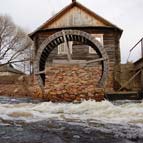
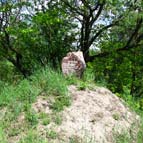
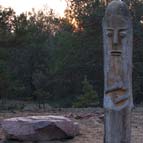
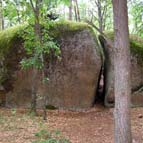
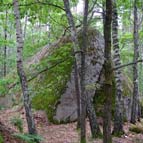
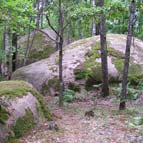
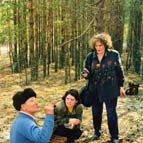
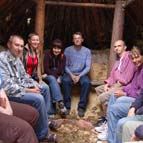
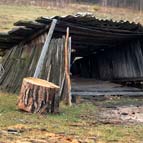
Marches and beavers
On one of our tours of the Preserve we were taken into the marshes
– and we rode in a military “all-terrain vehicle” to get
there and safely back. When we arrived at our destination, we got
out and looked around – we were surrounded by birches and pines; underfoot
were grasses, lichens and moss. In response to the interest we showed
in this moss, we were told that the scientific name for the moss in
those marshes was Sphagnum (in everyday English, it is called bog
moss, or peat moss); during WWII local partisans used
certain kinds of moss for applying it to the wounds – it was believed
to be helpful in the healing process.
All the trees that grow in the bogs are much lower than elsewhere,
and a pine can be over a hundred years old yet to be quite small.
We were there on a sunny day, but l could easily imagine how spooky the place must look on a gloomy, foggy or rainy day. It is so easy to get lost in such a place – and one wrong step and you can get sucked into the bog. No wonder, l thought, the Nazi Germans could not capture local partisans!
In the soviet times, marshes and bogs in large areas of Polissya were drained but the land was not properly cultivated and the marshes began to come back. Beavers proved to be the best local environment-protection workers – their dams and underwater lodges helped heal the wounds inflicted on the land by short-sighted “ameliorators”. Some of the beavers’ dams keep the difference in the level of the water as high as almost two meters. We were even asked to test by ourselves for durability one of such dams which was constructed witch was constructed with boles and branches that had been cut down by the beavers’ amazing incisors. We climbed onto one and even jumped in unison – the dyke felt as though it had been made of reinforced concrete. What looked like piles of branches and twigs that we saw in many places turned out to be the tops of beavers’ homes, and they proved also very resistant to any attempts to dislodge them.
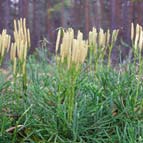
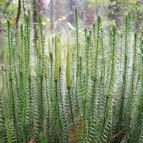
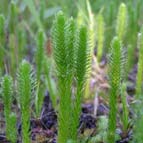
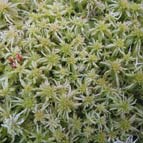
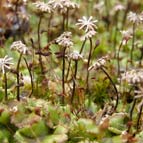
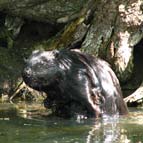
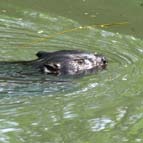
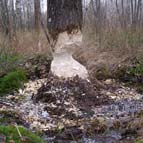
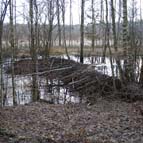
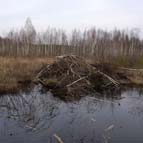
Wild bees
Even before we had started on our trip, while still in Kyiv, Yarko
had told us that we would see traditional beehives from which the
locals got their wild honey. And we did see them! Such beehives are
locally called “bort”, and this kind of wild
bees’ keeping for their honey is called “bortnistvo”.
“Bort”is made of a hollowed tree trunk, and they
are usually hung up high on a pine.
Instead of smoking out the bees from the nests in the holes in free
trunks to get honey, people, back in the times of old, began making
such simple home for the bees, from which it would be possible to
honey more easily.
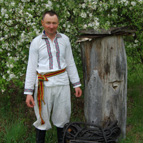
Bortnistvo was known not only in Ukraine but in other parts of Europe as well, but today only at very few places this old-style honey procuring business is still practiced the way it was done hundreds of years ago.
In Polissya, borti were passed from father to son for generations. Some of those still used by the villagers of Polissya are more than fifty or even a hundred years old. About one fourth of all the borti that can be found in the vicinity of the village have bee families which provide the locals with honey.
It is rather a tricky business to lure bees into a bort’ – you have to use a lot of skill, patience, ingenuity, and even certain spells to ensure occupation by bees of your bort’. Bortniky (bee keepers) are particularly superstitious; they keep their secrets and are reluctant to talk to strangers. In olden times, they were even more secretive.
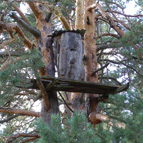
We saw quite a number of borti close to the village and in the forests. One of them had a curious contraption installed – protection against bears. It looked like a pitched roof firmly fixed to the bort’ -no bear would be able to put his paw into it, or tear the roof off. We were told that the borti used to be suspended hanging from a branch on a chain. If the bear climbed up to it, he would attempt to somehow grab it – but pushing or pulling the bort’ he set it into a swinging motion and the bort’ was heavy enough to knock him off the free. And at the place where he was likely to land there were sharp-pointed sticks dug into the ground. Cruel but effective.
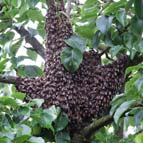
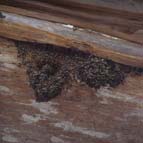
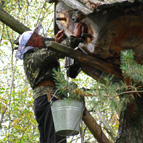
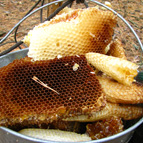
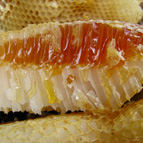
The visit to the Polissya Preserve took me back in time – and to the wonderful, pristine, scenic wild nature.
Olena Krushynska, Welcove to Ukraine, 3 – 2008.